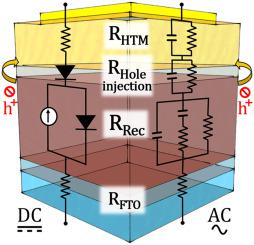Nano Energy ( IF 17.6 ) Pub Date : 2020-12-14 , DOI: 10.1016/j.nanoen.2020.105658 Boer Tan , Sonia R. Raga , Kevin James Rietwyk , Jianfeng Lu , Sebastian O. Fürer , James C. Griffith , Yi-Bing Cheng , Udo Bach

|
Hole transporting materials (HTMs) play essential roles in facilitating hole extraction and suppressing recombination in lead halide perovskite solar cells (PSCs). High levels of p-doping in HTMs is necessary for achieving high device performance, attributed to an increased electrical conductivity. In this work, we provide evidences that the poor performance of PSCs with low levels of doping (i.e., 4 mol% spiro-OMeTAD+) in spiro-OMeTAD is mainly caused by the presence of a Schottky barrier at the perovskite/spiro-OMeTAD interface, hampering hole injection. Under continuous illumination at open-circuit condition, the barrier gradually diminishes, increasing the PSC power conversion efficiency by 70-fold after 7 h. This process is completely reversible, returning to the initial poor performance after dark storage. We attribute this improvement in performance to a gradual photodoping of spiro-OMeTAD, triggered by the transfer of photogenerated holes and mediated by the slow migration of halide anions from perovskite to compensate the newly formed spiro-OMeTAD+. In-situ parallel analyses with impedance spectroscopy (IS) and photoluminescence are employed to gain insights into the charge dynamics along with light soaking. We find that the Schottky barrier resistance overlays with the recombination signal at the high frequency arc of IS, having important implications for the IS data analysis for PSCs. The work elucidates a major mechanism causing the slow efficiency variations during light/dark cycling, commonly observed in PSCs, which complicates the determination of long-term stability.
中文翻译:

螺-OMeTAD光掺杂对钙钛矿太阳能电池可逆光诱导的瞬态的影响
空穴传输材料(HTM)在促进空穴提取和抑制卤化钙钛矿型钙钛矿太阳能电池(PSC)中的复合中起着至关重要的作用。HTM中的高水平p掺杂对于实现高设备性能是必要的,这归因于电导率的提高。在这项工作中,我们提供的证据表明,掺杂水平低(即4 mol%的螺-OMeTAD +)在siro-OMeTAD中的主要原因是钙钛矿/螺-OMeTAD界面处存在肖特基势垒,阻碍了空穴注入。在开路状态下连续照明下,势垒逐渐减小,在7小时后,PSC功率转换效率提高了70倍。此过程是完全可逆的,在黑暗存储后恢复到最初的不良性能。我们将性能的提高归因于螺-OMeTAD的逐渐光掺杂,这是由光生空穴的转移触发的,并且是由钙钛矿中卤化物阴离子的缓慢迁移介导的,以补偿新形成的螺-OMeTAD +。利用阻抗光谱(IS)和光致发光进行原位并行分析,以深入了解电荷动力学以及光浸泡。我们发现肖特基势垒电阻在IS的高频弧上覆盖有重组信号,这对PSC的IS数据分析具有重要意义。这项工作阐明了在PSC中常见的导致明/暗循环期间效率缓慢变化的主要机理,这使长期稳定性的确定变得复杂。

























 京公网安备 11010802027423号
京公网安备 11010802027423号